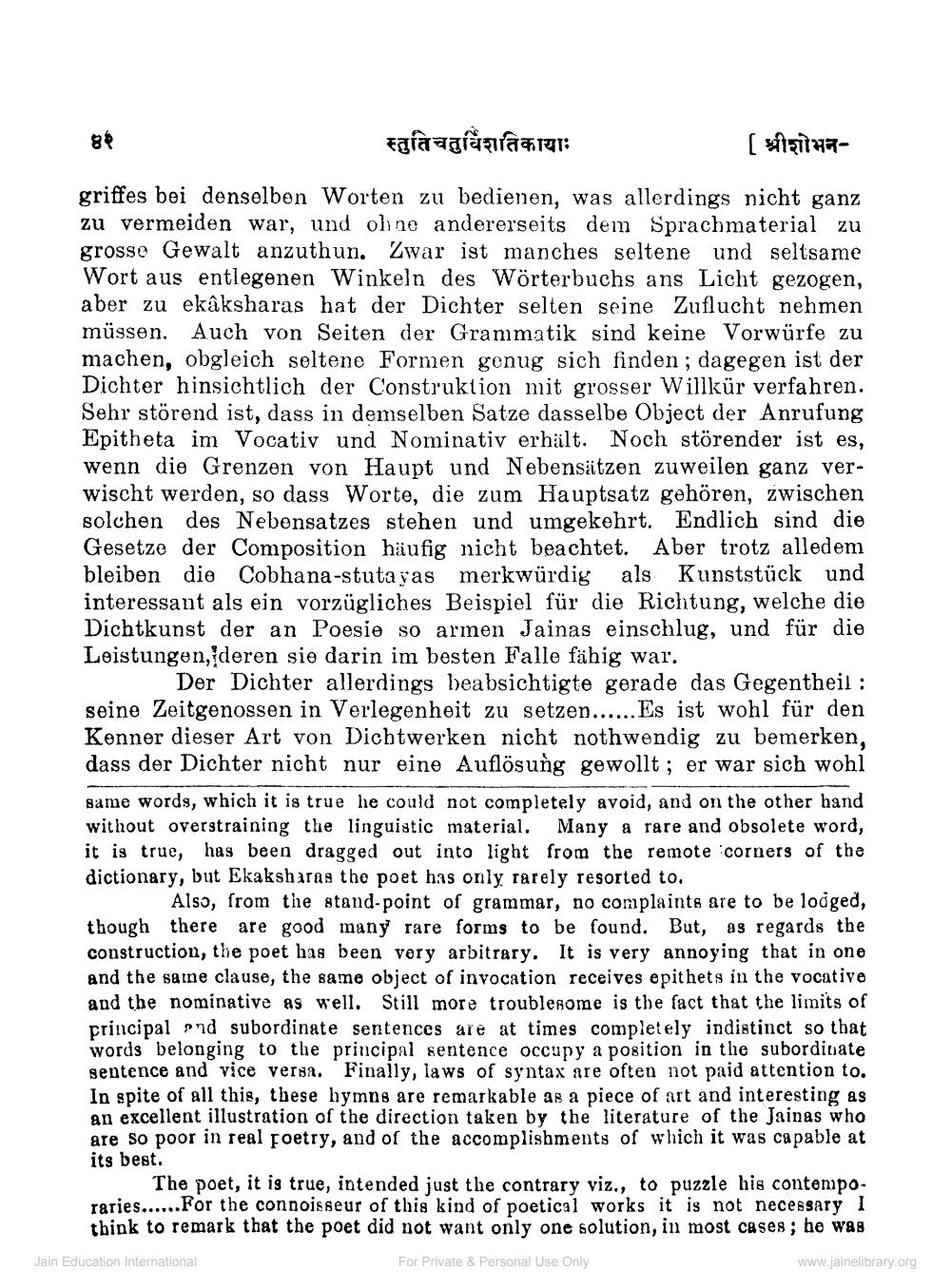________________
स्तुतिचतुर्विंशतिकायाः
[ શ્રીગોમન
griffes bei denselben Worten zu bedienen, was allerdings nicht ganz zu vermeiden war, und ohne andererseits dem Sprachmaterial zu grosse Gewalt anzuthun. Zwar ist manches seltene und seltsame Wort aus entlegenen Winkeln des Wörterbuchs ans Licht gezogen, aber zu ekâksharas hat der Dichter selten seine Zuflucht nehmen müssen. Auch von Seiten der Grammatik sind keine Vorwürfe zu machen, obgleich seltene Formen genug sich finden; dagegen ist der Dichter hinsichtlich der Construktion mit grosser Willkür verfahren. Sehr störend ist, dass in demselben Satze dasselbe Object der Anrufung Epitheta im Vocativ und Nominativ erhält. Noch störender ist es, wenn die Grenzen von Haupt und Nebensätzen zuweilen ganz verwischt werden, so dass Worte, die zum Hauptsatz gehören, zwischen solchen des Nebensatzes stehen und umgekehrt. Endlich sind die Gesetze der Composition häufig nicht beachtet. Aber trotz alledem bleiben die Cobhana-stutayas merkwürdig als Kunststück und interessant als ein vorzügliches Beispiel für die Richtung, welche die Dichtkunst der an Poesie so armen Jainas einschlug, und für die Leistungen, deren sie darin im besten Falle fähig war.
89
Der Dichter allerdings beabsichtigte gerade das Gegentheil : seine Zeitgenossen in Verlegenheit zu setzen......Es ist wohl für den Kenner dieser Art von Dichtwerken nicht nothwendig zu bemerken, dass der Dichter nicht nur eine Auflösung gewollt; er war sich wohl same words, which it is true he could not completely avoid, and on the other hand without overstraining the linguistic material. Many a rare and obsolete word, it is true, has been dragged out into light from the remote corners of the dictionary, but Ekaksharas the poet has only rarely resorted to.
Also, from the stand-point of grammar, no complaints are to be lodged, though there are good many rare forms to be found. But, as regards the construction, the poet has been very arbitrary. It is very annoying that in one and the same clause, the same object of invocation receives epithets in the vocative and the nominative as well. Still more troublesome is the fact that the limits of principal and subordinate sentences are at times completely indistinct so that words belonging to the principal sentence occupy a position in the subordinate sentence and vice versa. Finally, laws of syntax are often not paid attention to. In spite of all this, these hymns are remarkable as a piece of art and interesting as an excellent illustration of the direction taken by the literature of the Jainas who are so poor in real poetry, and of the accomplishments of which it was capable at its best.
The poet, it is true, intended just the contrary viz., to puzzle his contemporaries......For the connoisseur of this kind of poetical works it is not necessary I think to remark that the poet did not want only one solution, in most cases; he was
Jain Education International
For Private & Personal Use Only
www.jainelibrary.org




